
13 minute read
with Samantha SteeleBe Well
BE WELL

Overwhelming scientific evidence shows that the environment within our homes often contains pollutants, and that illnesses caused by exposure to these pollutants can be a serious threat to our health. Even the newest and most “efficient” homes can lack airflow, and certain building materials and furnishings are known to off-gas harmful substances. In fact, studies from around the world have directly linked the exponential rise of degenerative disease in our country to the exposure of harmful chemicals in our workplaces, water, and homes.
So many of us have been trapped inside with the recent COVID restrictions; we have been even more overloaded with indoor toxins, which can compromise the immune system. Removing this immune stress gives us the power and literally the “breathing room” to repair and/or maintain health, especially during such a critical time as this. By proactively detoxing the air and water in your home, you can create a safe haven from contaminants and improve your overall health and well-being.
Detox Your Home
By Samantha Steele
AIR
Put Houseplants to Work
Indoor plants not only brighten your home, they are very useful in purifying the air and adding oxygen to your space. In a significant 1989 experiment conducted by NASA, researchers looked for ways to effectively detoxify the air within space station environments. They found that indoor plants can effectively scrub the air of cancer-causing volatile organic compounds (VOCs) like formaldehyde and benzene. Further research found that soil microorganisms in potted plants also play a part in cleaning indoor air. Palms, spider plants, dracaena, pothos, philodendrons, sansevieria, rubber plants and peace lilies are good choices for indoor air purifiers.
Old Air out, Fresh Air in
Change your HVAC air filters about every three months, more as needed. Choose a high quality filter that attracts and captures microscopic particles such as smoke, molecules from coughs and sneezes, bacteria and viruses, as well as large particles, such as lint, household dust and pollen. Open your windows and doors for some fresh, circulated mountain air! Spring is a wonderful time to pull out all your stored window and door screens and open up the house to air it out. Allow the wind to briskly blow through all your spaces, freshening your indoor air with the cool mountain breezes. When wintertime returns, consider purchasing an indoor air purifier that filters out dust, molds, bacteria and viruses.
Ditch Artificial Fragrances
The synthetic scents used in plugins, canned air fresheners, and other “fragrance mechanisms” contain toxic substances, some of which are actually neurotoxins that can affect your brain. Instead of that plug-in or aerosol freshener, use an essential oil diffuser or a nebulizing machine to diffuse pure essential oils. Some of my favorites are thyme, rosemary, and eucalyptus, especially during “virus season.” Lavender, lemon and peppermint are also nice, clean fragrances. Some essential oils are processed with solvents that have harmful VOCs, so choose botanical fragrances that are organic or wild-crafted, and that are extracted through distillation, not with solvents. Seek out the purest oils that you can find for the most profound effects on air quality.
WATER
The Basics of Bathing
I’m hoping by now, most of us realize the importance of consuming plenty of fresh, clean water each day. But is your water really “clean”? If you have a municipal water supply, it definitely contains high amounts of chlorine. It would be very wise to filter the chlorine out of your drinking water, but if it’s in your budget, consider filtering the water you shower and bathe in as well; bathing in chlorinated water can kill the good bacteria that resides on your skin. You might ask, “Isn’t that a good thing?” Actually, it’s not.
According to the U.S. National Library of Medicine, part of the National Institutes of Health (NIH), “Symbiotic microorganisms occupy a wide range of skin niches and protect against invasion by more pathogenic or harmful organisms. These microorganisms may also have a role in educating the billions of T cells that are found in the skin, priming them to respond to similarly marked pathogenic cousins.” Plainly put, a healthy skin microbiome will act as a primary defense against invaders, and killing your skin microbiome with harmful chemicals such as chlorine can be bad for your health.
Drinking Water Options
So many folks spend quite a bit of money on bottled water out of convenience. Why not install a water filter instead? It is well documented that dangerous toxins from plastic water bottles can leach into your water. The most notable of these is bisphenol A (BPA). BPA can cause a myriad of health problems. According to the Mayo Clinic, research has shown that BPA can seep into food or beverages
from containers that are made with BPA. BPA is a concern because of its possible health effects on the brain and prostate gland of fetuses, infants and children. Because BPA affects the hormones in our bodies, and hormones often affect our behavior, BPA can also negatively influence children’s behavior.
If you have well or spring water, that is generally best since it contains many essential minerals that may otherwise be lost through purification processes; however, you might want to have your water tested for purity and heavy metals. If you opt for an in-house water purifier, I suggest adding minerals to your water with a 1/2 teaspoon of Celtic Sea salt per 12 ounces of water to replenish the minerals lost in the filtration process.
Below are a couple of other topics worth mentioning to improve your home environment and your health.

LIGHTING
Rely on Natural Light
If you have windows in your home, make a point to raise those shades and read and work by natural light. Get outside as soon as you wake to regulate your circadian rhythm. For the most pure form of lighting, try spending more time outside in a shady part of your yard, or on a covered porch. Ditch any fluorescent lights and install full spectrum color LED lights. Full spectrum lights offer a more natural light that has been shown to improve mood and circadian rhythm, and promote overall well-being.
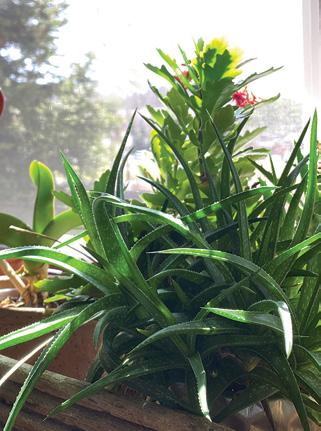
FREQUENCIES
Reduce Exposure to EMFs
Beware of Electro Magnetic Frequencies (EMFs) from wifi, appliances, and meter boxes. EMFs are still under investigation as far as the risk they pose to humans. You can mitigate the risk by turning off your cell phones at night or at the very least, turn them on airplane mode when not in use.
Be Well
References:
https://ntrs.nasa.gov/citations/19930072988. The Nader Report, Troubled Waters on Tap – Center for Responsive Law Dangers of Chlorine. http://curezone.com/art/read.asp?ID=21&db=3&CO=7. Jerry Smith. Accessed 29 May 2008. https://www.mayoclinic.org/healthy-lifestyle/nutrition-and-healthy-eating/expert-answers/bpa/faq-20058331 https://www.ncbi.nlm.nih.gov/pmc/articles/PMC3535073/figure/F1/ https://www.ncbi.nlm.nih.gov/pmc/articles/PMC3535073/figure/F1/ https://www.ucsf.edu/news/2017/06/407416/toxic-exposure-chemicals-are-our-water-food-air-and-furniture https://ournaturalroots.com/facts-about-chlorinated-water-that-cannot-be-ignored/


WORLD CLASS POTATO VODKA


GREAT PRICE Gluten-free Available in the High Country
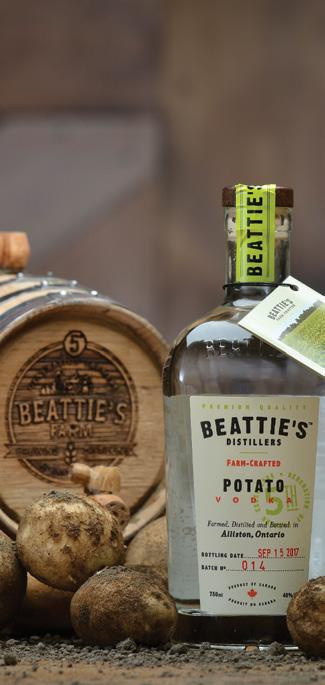
• S R O T A N I L L O P L A I T N E S S E • S T N A L P E S U O H H S U L • S B U R H S D N A R H O D I E S G A LO R E • O R G ANI “Let us make your C H garden successful!” E R B S Custom planted containers. • Landscape design & consultation. H E I Garden essentials. R L O O M V E G G I E S • C O L O R F U L A Your Favorite Destination Garden Shop N N U A L Mon - Sat 9am-6pm S 5589 Hwy 321 S, Blowing Rock 828-295-4585 • H A www.themustardseedmarketnc.com R D Y
ES E R T E V I TA N S L A I N N E R PE
Fresh Ingredients Handcrafted Dough ~ WORLD CLASS PIZZAS ~
BAKERY . FULL BAR ARCADE/MINI GOLF
402 Beech Mountain Pkwy, Beech Mountain, NC 28604 www.famousbrickoven.com . 828-387-4209
EMU • BISON • VENISON • ELK • BOAR • MOUNTAIN TROUT • DUCK

BISON
HANGING TENDERLOIN
AAA FOUR DIAMOND RATING SINCE 2007
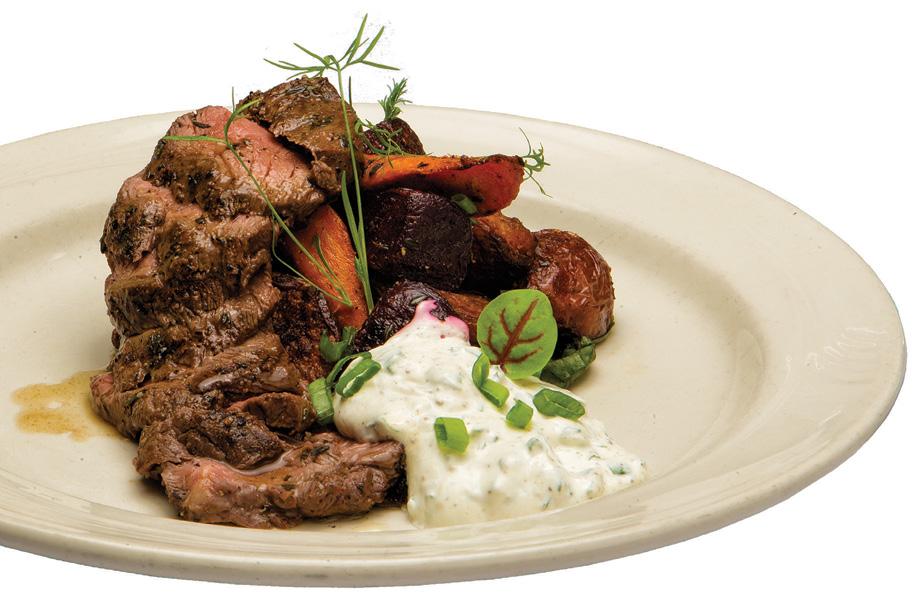
3005 SHULLS MILL ROAD BETWEEN BOONE & BLOWING ROCK | (828) 963-7400 | RESERVATIONS REQUIRED
Down on the microfarm, a superfood boosts the High Country’s well-being and good taste!
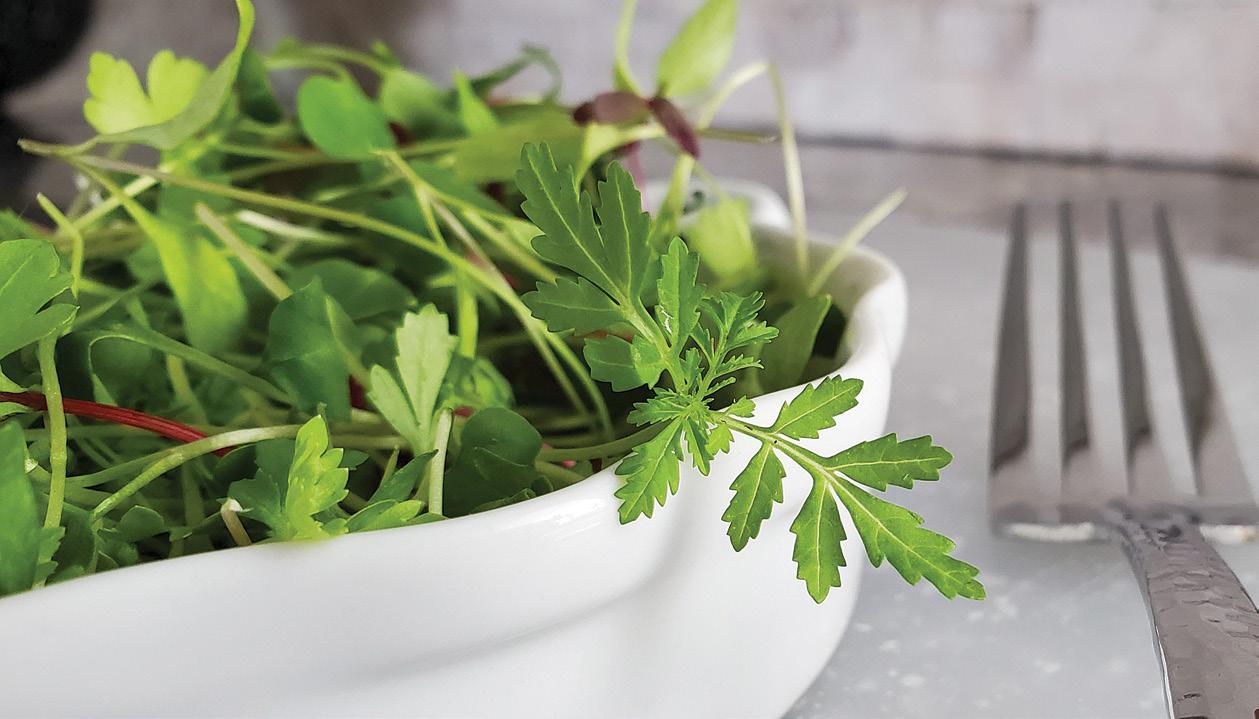
35 Shades of Micro Green:
The Tinier the Leaf the Healthier to Eat
By Gail Greco
The grab-and-add simplicity of flavor-enhancing microgreens speeds cooking prep in my High Country kitchen. No bigger than a pinky, they’re micro in size, macro in benefits, with experts touting them as the most nutritious veggies on the planet. And they’re uniquely available from a local grower, Sunshine Cove Farm in Valle Crucis (www.sunshinecovefarm.com).
A handful served raw satisfies a veggie course that’s easy-peasy healthy in a snap—no cutting board or paring knife in sight. You can stop right there, or with only a tad more effort, be foodalicious: fennel greens and microbasil whirled into my pesto… mustard greens whipped tangy into my white-bean dip for soft-pretzels and a beer chaser… beetroot and cress greens egged on in a skillet for breakfast. Tonight, it’s a rainbow of micro veggies (that kids won’t detect) tucked into a bacon-ranch macand-cheese... for dessert, nutty/sweet sunflower greens baked in a strawberry bread. And why not?
“They go with anything, and pack markedly more nutrients than their full-grown vegetables,” answers Larson Smith, Sunshine Cove (SCF) owner since 2017. He operates the smallfootprint farm, or microgreenery, with partner Michelle Dineen, growing up to 35 varieties all year long. “Pea tendrils are just springing up,” reports Smith. Hmmm… swirl them into my creamy baked potato soup? Drop them into a carrot-mushroom stirfry? Varying flavors inspire new dishes and refresh faves.
Microgreens boast familiar names, such as spinach and cauliflower, as well as heirlooms, including mizuna (Aztec) red amaranth. That’s because technically they are those vegetables at seedling stage, with leaves unfurling cheerfully— lacy and fluffy, floppy tender—mostly in shades of green. Popping up in trays of enriched soil, they stretch across a giant greenhouse like a magic carpet of life.
Sunlight blasts the greens with detoxifying phytonutrients, which in humans can foil viral infections, douse inflammation, improve brain function, reduce blood pressure, balance hormones, and offer vitamins/minerals for everyday well-being. According to a University of Maryland College of Agriculture study, microgreens have four to 40 times more nutrients than their mature veggie counterparts.
A kapow of healthy compounds are found in other SCF small-sized crops, as well: palm-size eggplants, peppers, and one-inch eggs from a perky flock of quail. But it’s as much as 30 pounds weekly of microgreens that keep the farm busiest—a huge yield since each green is lighter than a feather!
The farm touts its carefully crafted culinary mixes as “unlimited meal expanders.” For example, kohlrabi and purple radish greens in Purple Haze change up the flavor in, say, salmon or crab cakes. Blowing Rock’s Dawn Sullivan is convinced that SCF’s Pico de Gallo Mix (microherb cilantro, tangerine gem, onion greens) “is why everyone devours my smoked brisket tacos. The leaves, plopped on top of the filling, give the tacos a delightful and unexpected citrusy tang, balancing the woodsy meat and spicy sauce. As a great convenience food that goes a long way, it’s this kind of simplicity that makes you a better cook!” Sullivan is a regular shopper at the Watauga County Farmers’ Market, and is currently working on her own cookbook for family and friends, who are eager to know her secrets. The Pico mix will surely be one of them!
SCF veggies can be purchased at Be Natural Market, the High Country Food Hub, local farmers’ markets, and familiar restaurants, including Vidalia, Joy Bistro, Wild Craft, Rowlands, Booneshine, and Lost Province. Vidalia chef owner Sam
Photos by Tom Bagley

GREENS WITH COTTAGE CHEESE

BOOSTING EGG FLAVOR

Ratchford works with whatever SCF brings—“Farmer’s Choice,” he calls it— for edible garnishes, spring rolls, dressings, and entrees, such as steak pepperseasoned with micro arugula. Speaking of farm-to-table, SCF greens have also been served by Vivian Howard, PBS-TV cooking show host and owner of Chef and the Farmer Eatery in Kinston, NC.
Boone resident Karl Mohr is a husky 6’3” guy you wouldn’t think could be satisfied chowing down on a bowl of teeny leaves. But he’s passionate about them. After work, either on a construction project or spinning tunes as a disc jockey for his Mohr Fun Events business, he adds olive oil and a squeeze of lemon to a two-ounce SCF Market Mix, “and I call it dinner! Once you taste ‘em, you get it. This is not rabbit food.”
Mohr believes, “Quality is what makes the difference so that you’ll eat them at all, and why Sunshine Cove is so important to our area.” He’s coaxing his five-year-old daughter Nola to eat them, too. “I’m getting there,” he shrugs.
While many children wrinkle their noses at certain foods, even miniature kale, collard, and chard, nutritionists suggest kids will eat what they grow. “We have kits for DIYers, who supplement quantity and variety with our packaged greens,” adds Dineen.
Health coach Sandra Diaz of Todd eats the greens all day, as snacks, too. “A painless way to get your veggies,” she advises. “It’s shocking how good they are for you.”
Broccoli greens, packaged separately, or in the SCF blends Mediterranean Mix and Wasabi Heat, contain sulforaphane, a serious cancer preventative/cell-growth inhibitor. Kitty Rosati, Durham resident and author of The New York Times bestseller The Rice Diet, gets them for a friend battling cancer. She applauds SCF for “offering food as medicine.”
And what about as a life force for the soul? Traditional veggies are the cornerstone for many delicious meals. They add fiber and their own nutrient value, so the peeler and grater stay nearby. But, microgreens—strong as they are delicate and dainty—add a culinary grace to the kitchen no other veggie can, proving the timeless adage: Good things really do come in small packages!
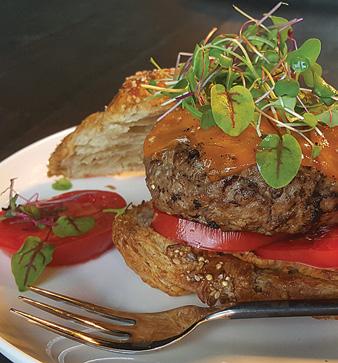
MAGIC CARPET OF LIFE
PLOPPED ON A BURGER
Gail Greco is a multi-media food journalist, author of 15 cookbooks and recipe videos, and former executive producer/host of the James Beard award-winning national PBS-TV series, Country Inn Cooking. Larson Smith and Michelle Dineen of Sunshine Cove Farm

MICROGREENS:
What You Want to Know
n Microgreens appeared in the late 1980s as a restaurant garnish. A few years later food scientists announced their nutritional benefits, and they caught on with an emerging healthconscious consumer.
n Microgreens are often confused with sprouts; microgreen leaves are full-grown, while sprouts are harvested before they leaf out, so less nutritious. n Toss micros raw in a salad or slaw, blend in a smoothie or juice them, and don’t forget to add them to take-out meals.
n Microgreens can be preserved frozen or in CML’s exclusive brine/pickling recipe: Add 4 cups or more greens to a mix of ½ cup apple cider vinegar, 1½ cups water, 1 tablespoon sugar, 2 teaspoons salt, 2 cloves garlic. Sit overnight in the fridge. Serve the next day or keep longer; they stay crunchy for days and go well with fish, sandwiches, burgers, or cottage cheese. n Cooking over high heat can cause nutrient loss, but not flavor; add microgreens last minute to stovetop preparations. n Microgreens offer baked goods a hint of spice. Add whole or chopped, depending on what’s baking. n From seed plot to plate, growing at home can be fun. For growing tips and trouble-shooting, search online or talk to Sunshine Cove Farm (www. sunshinecovefarm.com).




